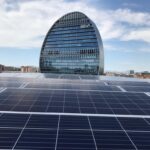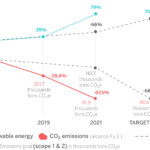In 2021, 79 percent of energy consumption at BBVA's facilities around the world came from renewable sources, surpassing the 70 percent target set in its 2025 Pledge on direct environmental impacts. The bank has also managed to reduce its direct CO2 emissions worldwide by 67.5 percent compared to 2015, very close to the 68 percent target set for 2025.

BBVA has surpassed its target set in the 2025 Pledge by nine points. The Pledge states that from that year onwards, 70 percent of the energy consumed by the bank must be renewable. Thus, in 2021, 79 percent of the energy consumed in its facilities came from clean energy, compared to 39 percent in 2019. In Spain, Portugal, Colombia, Uruguay and Turkey, 100 percent of the energy consumed by BBVA already comes from renewable sources, and in Mexico, 75 percent.
BBVA's climate change strategy, as set out in the Pledge 2025, aims, on the one hand, to reduce Scope 1 and 2 CO2 emissions by 68 percent (Scope 1 emissions are direct emissions produced by the burning of fuels by the emitter, while Scope 2 emissions are indirect emissions generated by the electricity consumed and purchased by the emitter) compared to 2015. It also sets the goal of 70 percent of energy consumed coming from renewable sources by 2025, and 100 percent by 2030.
In relation to the latter target, BBVA has been a member of the RE100 initiative since 2018, through which the world's most influential companies make the commitment to ensure that 100 percent of their energy comes from renewable sources by 2050.

Global Eco-efficiency Plan 2021-2025 (GEP 21-25)
BBVA has also set other ambitious targets in its climate strategy. These are included in the Global Eco-efficiency Plan, which has been in force since 2008 and was renewed in 2021 for the 2021-2025 period. These targets focus on reducing direct impacts and achieving the Pledge 2025. The plan articulates a global strategy to reduce direct impacts around four main pillars:
- consumption reduction through energy efficiency initiatives;
- use of energy from renewable sources;
- awareness and involvement of employees and other stakeholders on the path to a low-carbon economy;
- and offsetting its carbon footprint by purchasing credits from Voluntary Carbon Market projects to meet its commitment to be a carbon neutral company by 2020.
Several lines of action were defined in order to implement the plan:
Consumption
With the aim of reducing its environmental footprint, BBVA focuses on the use of renewable energies to contribute to the decarbonization of the markets where the Group operates. Its target is to reach PPA (Power Purchase Agreement) agreements like those in place in Mexico, Spain and Argentina, and to acquire international guarantees of origin or certifications for renewable energies. Moreover, in Spain, Turkey and Uruguay, the bank is committed to the self-generation of renewable energy in its buildings through the installation of photovoltaic and solar thermal panels.
BBVA also promotes a series of savings measures to control consumption. Thus, in order to guarantee a reduction in water consumption, the bank is committed to gray water recycling systems or the recirculation of water for irrigation at its headquarters in Spain and Mexico, in addition to the installation of dry urinals in its buildings in Spain. To reduce paper consumption, the bank is prioritizing digitization and centralization of printing, as well as energy-saving measures in the management of its buildings.
Circular economy
One of the other main problems contributing to the acceleration of climate change is the generation of waste due to linear consumption practices. Therefore, BBVA is contributing to the transition towards circular consumption through sustainable construction standards and the implementation of Environmental Management Systems. With the goal of minimizing the amount of waste sent to landfills, the bank has set up differentiated and marked areas in its facilities that allow for the proper segregation and subsequent recycling of waste.
Carbon footprint
The carbon footprint, one of the main objectives established in the 2025 Pledge, is an indicator that measures the amount of greenhouse gases (GHG) that an organization emits into the atmosphere. It is measured in tons of CO2 equivalent (CO2e). Since 2020, BBVA has been a carbon neutral company, offsetting residual emissions through the purchase of credits in the Voluntary Carbon Market.
BBVA's total emissions are comprised of the following:
– Scope 1: these are the direct carbon emissions that come from stationary combustion (direct emissions from the use of fossil fuels for the operation of own-use building facilities); from mobile combustion (from the use of fuel by vehicle fleet); and emissions from refrigerant gases (from the use of air conditioning and refrigeration facilities): 49,639 tons of CO2e.
– Scope 2: indirect emissions from the companies that generate the energy consumed by the organization, electricity in our case, and which it needs for its daily operations: 42,355 tons of CO2e.
– Scope 3, which includes other indirect emissions, not recognized in Scope 2, which are emitted by other companies so that our activity can be carried out, such as those caused by the management of waste generated in our properties, business trips, by plane or train, and employee travel to reach their place of work: 9,432 tons of CO2e, as well as those of clients.
Therefore, BBVA continues to make progress in reducing its environmental footprint to 91,900 tons of CO2 emissions (Scope 1 and 2) in 2021.
Sustainable construction
Another one of BBVA's commitments under its Global Eco-efficiency Plan is to guarantee the implementation of the best environmental and energy standards in the Group's buildings. To meet this goal, the bank aims to achieve a large percentage of environmentally certified floor space. BBVA already has building certifications in 16 buildings, including the Group's headquarters in Spain, Mexico, Argentina and Turkey. In terms of management certifications, BBVA has implemented the Environmental Management System in 89 buildings and 1,034 branches, in order to control and evaluate the environmental performance of the operations carried out in its facilities. It also has other management certifications such as the WWF Green Office at its headquarters in Turkey and the Aenor zero waste seal for the Ciudad BBVA building in Madrid.